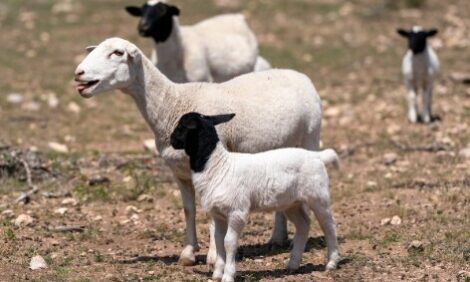



Weekly global protein digest: Tariffs expected to raise US beef prices
Livestock analyst Jim Wyckoff reports on global newsWeekly USDA US beef, pork export sales
Beef: Net sales of 11,900 MT for 2025 were up 28 percent from the previous week and 14 percent from the prior 4-week average. Increases primarily for South Korea (4,900 MT, including decreases of 400 MT), Japan (3,300 MT, including decreases of 300 MT), Mexico (1,100 MT, including decreases of 100 MT), Taiwan (1,000 MT, including decreases of 100 MT), and Hong Kong (600 MT), were offset by reductions for China (100 MT). Exports of 15,100 MT were up 1 percent from the previous week, but unchanged from the prior 4-week average. The destinations were primarily to South Korea (5,500 MT), Japan (4,000 MT), China (1,600 MT), Mexico (1,200 MT), and Taiwan (1,000 MT).
Pork: Net sales of 23,900 MT for 2025 were down 55 percent from the previous week and 23 percent from the prior 4-week average. Increases primarily for Mexico (8,900 MT, including decreases of 100 MT), Japan (3,600 MT, including decreases of 100 MT), South Korea (3,200 MT, including decreases of 500 MT), Colombia (2,200 MT, including decreases of 100 MT), and Australia (1,700 MT), were offset by reductions for Canada (100 MT). Exports of 30,100 MT were down 9 percent from the previous week and 8 percent from the prior 4-week average. The destinations were primarily to Mexico (11,700 MT), Japan (4,500 MT), South Korea (4,400 MT), China (2,500 MT), and Colombia (1,900 MT).
US food prices have continued to rise, with the food index increasing by 0.4% in March
Specifically, egg prices have surged significantly. As of March 2025, the average price for a dozen Grade A large eggs reached $6.23, up from $5.90 in February and $4.95 in January. This sharp increase is attributed to factors such as the avian flu outbreak, which led to the culling of over 30 million egg-laying hens earlier this year.
Of note: Despite the absence of new bird flu outbreaks and a decline in wholesale egg prices in March, retail egg prices have continued to climb, particularly ahead of the Easter holiday when demand typically rises. Additionally, major egg producers like Cal-Maine Foods have reported substantial profit increases, prompting the Department of Justice to investigate potential price-fixing within the industry.
Dairy, pork, and produce: Canada and Mexico’s critical role
Mexico remains a crucial market for U.S. corn, poultry, pork, and dairy, accounting for 5–7% of exports in each category. Canada, meanwhile, is a key destination for tree nuts, fruits, and vegetables, receiving about 5% of U.S. production in those groups.
What makes this concerning? These same categories make up a large portion of farm cash receipts, meaning any drop in export demand would “considerably reduce aggregate farm revenues,” the KC Fed explains.
Tariffs expected to raise US beef prices
President Trump imposed a 10% tariff on Australian goods while singling out the country’s beef exports for criticism on Wednesday. Australian farmers, traders and industry groups said on Thursday they would pass on any extra costs from tariffs to American consumers, potentially pushing up the prices of hamburgers and steaks. Australia exports around $2.5 billion worth of beef to the U.S. annually, its biggest market.
Weekly USDA dairy report
CME GROUP CASH MARKETS (4/4) BUTTER: Grade AA closed at $2.2950. The weekly average for Grade AA is $2.3290 (-0.0095). CHEESE: Barrels closed at $1.6600 and 40# blocks at $1.6400. The weekly average for barrels is $1.6605 (+0.0275) and blocks $1.6455 (+0.0110). NONFAT DRY MILK: Grade A closed at $1.1575. The weekly average for Grade A is $1.1665 (+0.0155). DRY WHEY: Extra grade dry whey closed at $0.4900. The weekly average for dry whey is $0.4935 (-0.0075).
BUTTER HIGHLIGHTS: Domestic retail butter demand continues to vary from steady to stronger. Domestic food service demand is weaker than domestic retail demand. Competitive domestic prices compared to international prices are helping to keep export demand in line with last week. Cream loads generally continue to be readily available. However, a few butter producers convey cream loads too inexpensive to pass up are no longer around. Many butter manufacturers have their churns running at or near full capacities. Bulk butter overages range from 5 cents below to 6 cents above market, across all regions.
CHEESE HIGHLIGHTS: Cheese plant managers in the East region share active cheese manufacturing schedules. Seasonally strong milk availability has enabled cheese inventories to grow. Some contacts note retail cheese demand remains steady while foodservice demand remains light. Cheesemakers in the Central region relay strong milk availability with spot milk prices falling between $4.50 to $2 under Class III. Ample milk availability has allowed cheese stocks to grow. Contacts in the region relay mixed demand. In the West region, both seasonal milk production and cheese production schedules remain strong. Contacts note block cheese inventories are growing faster than barrel cheese inventories. Retail demand continues to trend steady to stronger while foodservice demand is weak.
FLUID MILK HIGHLIGHTS: Spring flush is upon the nation’s dairy farmers. From East to West, milk yields are growing in seasonal fashion. Class I intakes are mixed. There are still some inconsistencies with school district intakes, as spring breaks are moving into the rearview mirrors of milk handlers. That said, some contacts say bottlers are not as active as they were earlier in the post-holiday schoolyear. Class III demands are strong, as cheesemakers take advantage of favorably priced milk volumes. Spot milk prices ranged from $4.50- to $2-under Class this week. Cream remains generally available across the country, but not at the elevated levels it was just a few weeks ago. Class II and Class III manufacturing has begun to seasonally pick up steam. Cream multiples ranged from 1.00 to 1.20 in the East, 1.00 to 1.18 in the Central, and .85 to 1.10 in the West.
DRY PRODUCTS HIGHLIGHTS: Low/medium heat nonfat dry milk (NDM) prices moved lower in all regions this week. As condensed skim becomes more available in the early spring, more condensed skim is changing hands at decreasing values. Dry buttermilk prices were steady to lower across the country. Marketers in the West region are a little more reluctant to offer volumes at the same price points as Central/ East region suppliers. Dry whey powder prices were mixed in the Central region, lower in the West and steady to lower in the East. Late week market activity showed some resilience according to Midwest market participants. Lactose prices moved higher during the first week of Q2. Whey protein concentrate 34% markets have maintained their recent and notable bullish trend. Dry whole milk prices dipped this week, while rennet and acid casein prices held steady.
ORGANIC DAIRY MARKET NEWS: The NOP Organic Insider sent out on April 1 discussed the Retail Toolkit, which was recently added to the Organic Integrity Learning Center. The NOP Organic Insider sent out on March 28 discussed the National Organic Standards Board (NOSB) Spring 2025 meeting which is scheduled for April 29 - May 1 from noon - 5:00 pm Eastern. The Pennsylvania Monthly Organic Dairy Report released April 4 showed the average price for fluid milk increased in January. The Vermont Monthly Organic Dairy Report released April 4 showed the average price for fluid milk increased in January. The Foreign Agricultural Service (FAS) monthly export data for organic milk categorized as HS-10 code 0401201000 indicated February 2025 organic milk exports were down from January 2025, but up from February 2024. Total organic dairy ads are up in this week’s retail ad survey, compared to the prior week's survey. The most advertised organic dairy product this week is milk, which compromises the majority of all organic dairy ads found this week.
NATIONAL RETAIL REPORT: Conventional dairy ads decreased by 13 percent, while organic dairy ads increased by 41 percent for week 14. On the conventional side, butter had the biggest percent increase in ad numbers, which was 85 percent. Cheese was the heaviest advertised conventional dairy commodity. Ice cream stayed ahead of yogurt for the second most heavily advertised conventional commodity spot this week. Conventional butter appeared in ads slightly more often than conventional milk this week. The organic premium for a half gallon container of milk is $2.89.
FEBRUARY AGRICULTURAL PRICES (NASS): The All Milk price received by farmers was $23.60 in February, up $3.00 from February 2024. The alfalfa hay price was $159.00 in February, down $42.00 from February 2024. The corn price was $4.58 in February, up .22 from February 2024. The soybean price was $10.20 in February, down $1.70 from February 2024. The milk-feed price ratio was 2.68 in February, up 0.55 from February 2024. The index of prices received by farmers for dairy products during the month of February 2025 was down 2.5 to 117.4. CO



